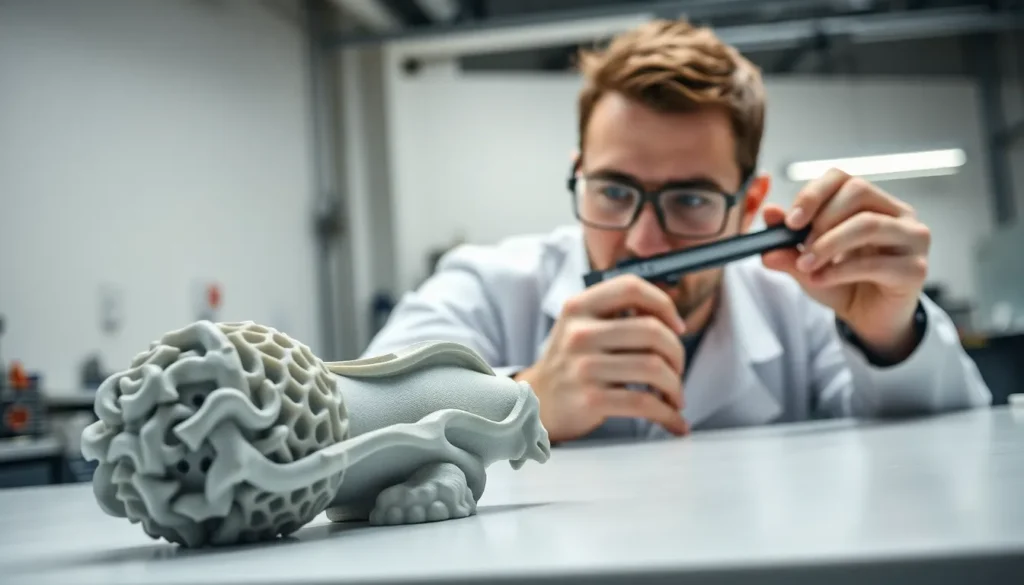In the wild world of 3D printing, quality can make or break a project faster than you can say “layer adhesion.” Imagine spending hours perfecting a design only to have it resemble a melted snowman. Not exactly the masterpiece one hopes for, right? Understanding print quality isn’t just a nerdy obsession; it’s the secret sauce to turning those digital dreams into tangible triumphs.
Table of Contents
ToggleUnderstanding 3D Print Quality
3D print quality refers to the overall characteristics and attributes of a printed object, including its precision, surface finish, and dimensional accuracy. Evaluating print quality involves examining various factors, such as layer adhesion and print resolution, which directly influence the final product.
Definition of 3D Print Quality
3D print quality describes how closely a printed object matches its intended design specifications. Key elements include layer height, resolution, and material consistency. Fine details in designs often require high resolutions for accurate reproduction. Print artifacts, like stringing or gaps, can negatively impact the aesthetic and functional aspects of the model. Distinct measurements like tolerance show how well parts fit together post-printing. Assessing these elements results in better understanding and improvement of print outcomes.
Importance of Print Quality in 3D Printing
Print quality holds significant importance in successful 3D printing projects. High-quality prints ensure that designs function as intended, reducing the need for revisions or reprints. Effective prints can better withstand mechanical stress and environmental conditions. Meeting industry standards often relies on maintaining high-quality processes. Businesses that prioritize print quality enhance brand reputation and customer satisfaction. Producing reliable parts can lower costs associated with material waste and time loss. Ultimately, superior print quality directly impacts performance and usability.
Factors Affecting 3D Print Quality

Multiple elements influence the final quality of a 3D print. Printer settings, material selection, and environmental conditions play significant roles in determining outcomes.
Printer Settings
Proper configuration of printer settings ensures optimal results. Layer height affects resolution, with finer layers yielding smoother surfaces. Print speed influences adhesion and detail; higher speeds often compromise quality. Temperature settings dictate melting points and flow rates, impacting layer bonding. Additionally, adjusting retraction settings prevents stringing and oozing, leading to cleaner prints. Calibration of the printer must occur frequently to maintain accuracy, enhancing dimensional integrity and overall quality.
Material Selection
Choosing the right material impacts both functionality and finish. Various filaments, like PLA, ABS, and PETG, possess unique properties. PLA offers ease of use and minimal warping, making it suitable for beginners. ABS provides durability, suitable for functional prototypes, yet requires careful temperature management. PETG combines strength and flexibility, ideal for parts under stress. Understanding material characteristics helps users find the best fit for their specific projects, directly influencing the printed item’s longevity and performance.
Environmental Conditions
Environmental factors significantly affect print quality. Room temperature and humidity levels can alter filament behavior during printing. A stable temperature reduces warping, while high humidity can lead to moisture absorption, impacting filament integrity. Ventilation also plays a role; good airflow prevents overheating of components. Dust or debris in the environment can cause clogs and uneven surfaces. Maintaining controlled conditions promotes consistent print results, supporting overall success in 3D projects.
Techniques to Improve 3D Print Quality
Enhancing 3D print quality involves several essential techniques, such as calibration, software settings, and post-processing methods.
Calibration and Maintenance
Regular calibration of the 3D printer ensures precision and consistency in prints. Users must adjust bed leveling and nozzle height to achieve optimal first layer adhesion. Maintenance routines, including cleaning and lubricating moving parts, prevent mechanical issues. Periodic inspection of printer components guarantees that they function correctly. Keeping the printer free from dust helps maintain performance. These steps collectively contribute to producing higher quality prints.
Slicing Software Adjustments
Proper adjustments in slicing software play a crucial role in print quality enhancement. Users should fine-tune layer height settings to balance detail and print time. Print speed modifications can help reduce blur and improve surface finish. Enabling features like stringing reduction can minimize unwanted filaments between layers. Additionally, adjusting temperature settings based on filament type influences layer adhesion. Taking these factors into account boosts overall print quality.
Post-Processing Methods
Post-processing techniques significantly enhance finish and functionality of printed objects. Sanding surfaces can eliminate rough spots and improve aesthetics. Painting or applying coatings protects prints from wear and tear while adding visual appeal. Additionally, incorporating chemical smoothing processes, like vapor smoothing for ABS, can yield a glossy surface. Implementing assembly methods, such as using adhesive for multi-part prints, creates a more refined final product. These methods ensure that the final results meet expectations regarding quality and performance.
Evaluating 3D Print Quality
Evaluating 3D print quality encompasses various techniques that assess the integrity and precision of printed objects. Both visual inspection and measurement techniques play critical roles in this process.
Visual Inspection
Visual inspection involves examining prints for surface imperfections and overall aesthetics. Observing layer lines helps identify print resolution issues. Look for gaps and misaligned layers to assess layer adhesion. The examination of surface smoothness reveals both texture and finish quality. Checking for unwanted artifacts, like stringing or blobs, indicates printing inconsistencies. Scanning for color uniformity ensures that the print aligns with design expectations. Such thorough inspection provides insights into potential flaws before moving forward with post-processing or use.
Measurement Techniques
Measurement techniques enhance the evaluation of print quality through precise data collection. Calipers offer accurate measurements of dimensions, confirming dimensional accuracy against design specifications. Identifying variations in thickness across printed parts ensures uniformity. Using dial indicators allows assessment of flatness or roundness in critical areas. Techniques, like applying gauges to check layer height, reinforce the understanding of print settings. Deviations from expected measurements often signal the need for adjustments in printer configuration. Accurate readings facilitate improvements and ensure that prints function effectively in real-world applications.
Achieving high-quality 3D prints is essential for successful project outcomes. By understanding the critical factors that influence print quality, individuals can transform their designs into functional and aesthetically pleasing objects.
Through careful calibration, material selection, and environmental control, it’s possible to enhance the overall quality of prints. Regular evaluation methods ensure any issues are identified and addressed promptly, leading to improved results.
Ultimately, prioritizing print quality not only boosts performance but also reduces waste and enhances brand reputation. This commitment to excellence in 3D printing sets the foundation for innovation and success in various applications.










